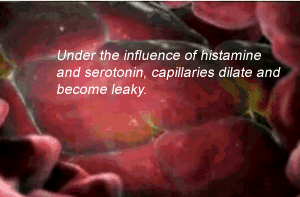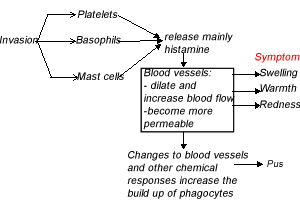Wound healing consists of three parts. What are they ?
What is the purpose of inflammation?
How do the tiny blood vessels, called capillaries, behave during inflammation?
What is phagocytosis?
What are fibroblasts?
Why is the proliferation of fibroblasts in the wounded area so important?
What is an endothelial cell? Why is proliferation of endothelial cells important?
Why is a newly formed scar pink?
Is scar tissue as strong as normal skin?
The site of infection, whether its due to pathogens or foreign matter, due to a cut in the skin, appears red, swollen and may even form pus. Quite often the site of infection is also painful.
We will take a look at what happens at the cellular level.

Normally the walls of the capillaries are thin enough for the exchange of gases and the passage of fluid through tiny gaps between the cells that form the walls. Red blood cells and large proteins are kept from escaping into the interstitial fluid.
Consider the image on the right. Blood cells can be seen flowing through the capillary.
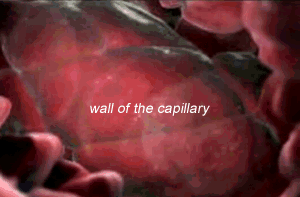
The inflammatory response is a natural defence mechanism to the presence of a pathogen or foreign matter in the body.
At the onset of the invasion by foreign matter mast cells, basophills and platelets release histamine.
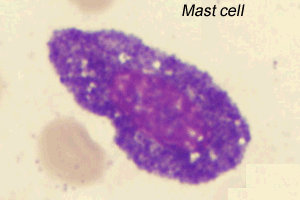
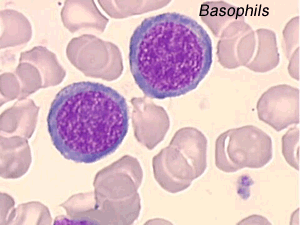
Histamine causes the local blood vessels to dilate and become leaky, as shown on the right. This causes an increase in blood flow to the affected area which results in redness, warmth and swelling.
As a result of the capillaries becoming more permeable, blood plasma leaks out resulting in swelling. Phagocytes more readily move through the walls of the capillaries and into the surrounding tissue where they engulf the foreign matter and eventually die to form pus.
